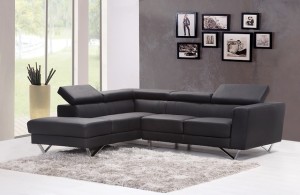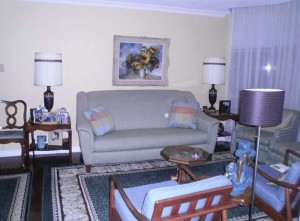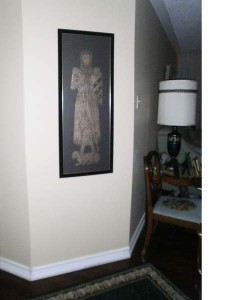Top Best Tips for Hanging Art
Have you ever gone to a friend’s house and noticed that the artwork was hung too high? It can be a little uncomfortable and a little comical at the same time. In my friend’s home the art was hung close to the ceiling. I refrained from giving unsolicited advice. Sometimes the artwork is not only hung too high but it is too small such that it is drowning in all the wall space. In the image below (Figure 1) the gallery wall display is hung too high above the sofa.
I am an artist with a lot of practice hanging art. I am also detailed orientated thus wanting to hang art correctly and tastefully. I’m the type that asks a lot of questions so over the years when I have been in doubt I have asked the experts. This quality comes in handy. This post will focus on choosing the best location and tips for measuring. For choosing the right hardware I direct you to your local hardware store. Follow my top best tips for hanging art like a pro and remember to have FUN!
- Before hanging your art choose a location that is away from direct light to prevent colours fading. Be sure to find a location away from humidity.
- If your art is heavy use a wall stud finder. Stud finders locate nails inside your wall. I have a small cheap one that works fine. If you don’t have a wall stud where you need it than there are several hardware options. Before purchasing hardware you will need to know if you have plaster walls, drywall, wood panels or masonry walls like concrete brick, concrete block or cement (you get the picture – pun intended). Masonry walls require drilling a hole with the appropriate drill bit. Talk to the staff at your local hardware store for your best hardware options.
- You may want to work with an assistant especially if your artwork is heavy. It’s more fun to work with someone.
- Try using white gloves to protect the artwork from damage and/or to prevent fingerprints and smudges.
- Stay away from using adhesive hooks. Since you are glueing the hook to the wall than the wall paint will be supporting the weight of the picture. In my opinion, this is putting your artwork at risk of damage.
- Place a folded blanket or equivalent on the floor to rest the art while you are measuring etc.
- For security sake, check that the wire on the picture frame is secure. Try holding the picture over your sofa or over cushions and hold the picture by the wire lifting it up and down carefully several times. Better to be safe than sorry. You don’t want to find your hung picture laying damaged on the floor because your hardware wasn’t secure.
- The center point of an art piece should be hung approximately 57” from the floor. In this way you are creating oneness with the art whether you are sitting or standing. Having said this, if you are really tall you may want to adjust this height to a maximum of 60” from the floor. The measuring is easy. First step is to measure from the floor up to 57” and lightly mark this spot on your wall. Step two is to find the center of the artwork by measuring its height and dividing by two. Step three is to ascertain the measurement of the taut wire by taking your finger or the tip of your measuring tape and pulling up. In this step you are measuring from the “taut wire” to the top of the picture (frame). Step four is to subtract the “taut-wire” measurement from the measurement you found in step two (centre of artwork). Step five is to take this measurement and add it to the 57”. Step six is to lightly mark this final measurement your wall. Step seven is to secure your wall fastener. In summary, you are trying to align the middle of the picture, minus the distance from the taut wire to the frame, to your eye-level measurement i.e. 57″.
- If your art is heavy try using multiple hooks. This not only helps to support the weight but it also helps to prevent the art from shifting and becoming crooked. All the measurements and formulas remain the same. Depending on the size of the art place the hooks 4″ to 5″ apart.
- You can also prevent art from shifting by placing Museum Putty on the bottom corners. You can purchase this putty from Home Depot.
- When hanging art above your bed leave approximately a 6″ – 12″ space above the headboard.
- I would suggest hanging art 8” – 12″ above your sofa so your family and guests’ heads are not going to accidentally hit your art.
- If your sofa is 6’ long and you have a couple of side tables don’t feel that your art has to stay within the limits of your couch.
- Before committing a nail/s and fasteners to the wall try cutting newspaper, to the same size as your art. You may need to tape pieces of newsprint together to get the right size template. Tape your new template(s) to the wall to get a feeling of placement. Use painters tape so you don’t damage your wall. This step will give you the confidence to put hammer to nail. Placing the templates on the wall will allow you to visualize the overall proportions and spacing. You will need to make some adjustments.
- When hanging art on a gallery wall meaning you are going to be hanging several pieces on a wall measure and mark the 57” from the floor. This mark is your “eye level”. Find the place you want to be the center of your grouping. This place will be along the established “eye level”. Plan your collection around this point. Now you are thinking of your collection as a whole. Find your largest piece and place it off centre and build your collection around it. Your large piece of art will anchor the wall and be the mainstay or cornerstone of your collection. Having a variety of sizes small, medium and large, will create interest and make the collection as a whole more dynamic.
- Spacing around each piece is required to allow the art to breath. It is not necessary to have even spacing around each piece of art that makes your collection. Try to line up the art to any line whether it is the outside frame or a line that the mat creates or a line that maybe within the actual art piece. You may ask yourself why am I doing this? You want the viewer to have a comfortable eye flow from one piece of art to another. Having your eye follow from one line in a piece of art to another line in another piece will create this flow. This is why it would be very different to have equal spacing between art pieces. I hope I have made this clear and easy to understand. Without a natural eye flow the eye is jumping from one piece of art to another. If the viewer’s experience is uncomfortable than the viewer will move on.
- When creating a cluster of art mix your art. Salt and pepper your dark pieces with your light pieces. Intermingle your colour pieces so they are not clustered together. Do the same with your photos – mix them with other mediums. Your frames do not have to be the same colour. Do mix and match them. Don’t have just one dark frame mix with light ones and the same goes for not having just one light frame mixed with all dark. The attention will go to the art that feels left out and not to the whole group as an unit.
- When hanging one picture centered over your sofa be sure it engages the space (see Figure 2). In others words the artwork needs to be large. The artwork can be making a bold statement or a quiet statement but it needs to make a statement and it can do this by its size.
- If you have two pictures to hang on a narrow wall, one above the other I would suggesting having the eye level between the two pictures. Therefore, one picture would be above the established eye level and the second picture will be below the eye level.
- On a narrow wall where there is no furniture to consider hang a narrow picture (see Figure 3).
- If you are wanting to engage a wall try hanging two paintings or more paintings.
Check out Donna’s website at www.donnawilsonartist.com



